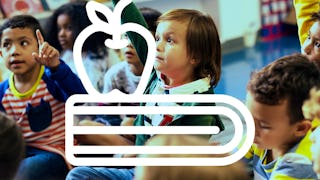Culture and language are inextricably linked. As teachers, we are often faced with the challenge of teaching both language and elements of culture to our English learners. When these students join our classes, they come equipped with knowledge about their own culture, which may or may not have the same norms and values as the new one they find themselves in. It is not our job, as teachers, to prove that one culture is better than another. Instead, it’s our goal to understand how culture influences one’s identity, affirm our students’ identities in the classroom, and use best practices to teach intercultural communicative competence and promote acceptance and respect for those who are different from us.

4 days left: Get a Black Friday boost with $160 off 10,000+ programs. Save now.


The Role of Culture in Teaching English Learners
This course is part of Introduction to Teaching English Learners Specialization


Instructors: Alice Llanos
1,701 already enrolled
Included with
(13 reviews)
Recommended experience
What you'll learn
Discover new ideas for teaching and assessing cultural knowledge and intercultural communicative competence.
Learn how to incorporate culturally responsive teaching methods into your everyday classroom practices.
Understand the multi-dimensional nature of culture and its importance in teaching English learners.
Skills you'll gain
- Lesson Planning
- Diversity Equity and Inclusion Initiatives
- Instructing
- Intercultural Competence
- Language Learning
- English Language
- Cultural Responsiveness
- Education and Training
- Mathematics Education
- Student Engagement
- Teaching
- Cultural Diversity
- Curriculum Planning
- Diversity Awareness
- Culture
- Pedagogy
- Cultural Sensitivity
Details to know

Add to your LinkedIn profile
See how employees at top companies are mastering in-demand skills

Build your subject-matter expertise
- Learn new concepts from industry experts
- Gain a foundational understanding of a subject or tool
- Develop job-relevant skills with hands-on projects
- Earn a shareable career certificate

There are 4 modules in this course
In Module 1, you will learn about the complex construct of culture and the various factors that influence it. We'll explore the concepts of personal, social, cultural, and linguistic identities and how we can affirm our students' identities in the classroom. You will be able to distinguish between the processes of enculturation and acculturation in order to better understand your English learners' perspectives of learning a new culture. We wrap up the module by reflecting on your own cultural background and the ways in which your life experiences and influences relate to your current points of view.
What's included
6 videos9 readings3 assignments1 peer review1 discussion prompt
Module 2 is all about becoming comfortable with culture, for both teachers and students. We'll become aware of possible implicit biases and power dynamics between teacher and students that may impact learning in the classroom. We'll introduce the concept of culture shock and discuss ways to help newcomer English learners adjust to their new learning environment. You will discover how asset-based pedagogy models, including Culturally Responsive Teaching (CRT), can foster academic success for English learners. We wrap up the module by evaluating curriculum for elements of culturally responsive teaching.
What's included
6 videos10 readings3 assignments1 peer review1 discussion prompt
In module 3, we will learn about the fundamental connection between culture and communication. You'll discover how culture affects language use and how language and thought are windows into cultural points of view. We introduce the crucial construct of intercultural communicative competence (ICC) and best practices to teach and assess it. You'll define a speech community and gain an understanding of the many speech communities your English learners have to navigate on a daily basis. We wrap up the module by evaluating a lesson for elements of ICC.
What's included
6 videos11 readings3 assignments1 peer review1 discussion prompt
The final module in the course aims to provide more practical tips for incorporating culture into the classroom across grade levels and subject areas. You will hear from experts about the various ways in which they have implemented culturally responsive teaching in math, STEM, art, and history. We'll review some traditional classroom activities for teaching about culture. You will gain insight into the best methods for and challenges of assessing cultural knowledge and ICC. We'll also highlight awareness of cultural biases in assessment and how to avoid them. The module wraps up with a lesson planning assignment in which you'll be asked to incorporate activities to teach ICC, cultural content knowledge, or implement culturally responsive teaching methods.
What's included
6 videos12 readings3 assignments1 peer review1 discussion prompt
Earn a career certificate
Add this credential to your LinkedIn profile, resume, or CV. Share it on social media and in your performance review.
Offered by
Explore more from Learning English
 Status: Free Trial
Status: Free TrialRice University
 Status: Free Trial
Status: Free TrialRice University
 Status: Free Trial
Status: Free TrialRice University
 Status: Free Trial
Status: Free TrialArizona State University
Why people choose Coursera for their career





Open new doors with Coursera Plus
Unlimited access to 10,000+ world-class courses, hands-on projects, and job-ready certificate programs - all included in your subscription
Advance your career with an online degree
Earn a degree from world-class universities - 100% online
Join over 3,400 global companies that choose Coursera for Business
Upskill your employees to excel in the digital economy
Frequently asked questions
To access the course materials, assignments and to earn a Certificate, you will need to purchase the Certificate experience when you enroll in a course. You can try a Free Trial instead, or apply for Financial Aid. The course may offer 'Full Course, No Certificate' instead. This option lets you see all course materials, submit required assessments, and get a final grade. This also means that you will not be able to purchase a Certificate experience.
When you enroll in the course, you get access to all of the courses in the Specialization, and you earn a certificate when you complete the work. Your electronic Certificate will be added to your Accomplishments page - from there, you can print your Certificate or add it to your LinkedIn profile.
Yes. In select learning programs, you can apply for financial aid or a scholarship if you can’t afford the enrollment fee. If fin aid or scholarship is available for your learning program selection, you’ll find a link to apply on the description page.
More questions
Financial aid available,
¹ Some assignments in this course are AI-graded. For these assignments, your data will be used in accordance with Coursera's Privacy Notice.

